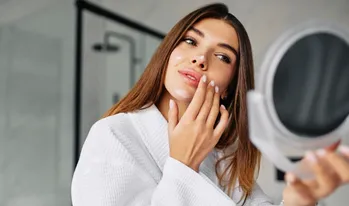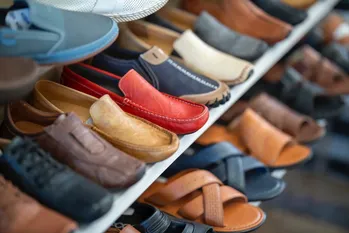As the beauty industry continues to grow, so does the cost of skincare products. It's not uncommon for a high-end moisturizer or serum to set you back several hundred dollars, leaving many people feeling discouraged and resorting to cheaper drugstore alternatives that may not be as effective. However, there are smart ways to save money on your skincare routine without sacrificing quality results. In this article, we'll share some tips and tricks to help you achieve healthy, radiant skin on a budget.
Understanding Your Skin Type
The first step in creating an affordable skincare routine is to identify your skin type. This will allow you to choose products that are tailored to your specific needs, which can save you money in the long run by preventing unnecessary purchases of products that won't work for you.
Common Skin Types:
Oily Skin - Characterized by excess sebum production, which leads to shiny and greasy skin. Prone to breakouts and blackheads.
Dry Skin - Lacks moisture, resulting in a tight or flaky appearance. May also experience fine lines and wrinkles due to lack of hydration.
Sensitive Skin - Reacts negatively to certain ingredients, causing redness, irritation, and itching. May have underlying skin conditions such as rosacea or eczema.
Combination Skin - A mix of oily and dry skin, with oiliness in the T-zone (forehead, nose, and chin) and dryness around the cheeks.
Normal Skin - Balanced moisture levels with no noticeable issues or concerns.
Tips for Identifying Your Skin Type:
Observe your skin's appearance throughout the day. Does it feel greasy by the end of the day, or does it look dull and dry?
Wipe a blotting sheet over your forehead, nose, and chin. If oil remains on the sheet, you likely have oily skin.
Check for signs of dryness or flakiness around your cheeks.
Determine how your skin reacts to different products. Does it become red or irritated after using a new cleanser or moisturizer?
Budget-Friendly Ingredients
Once you've identified your skin type, it's time to look for affordable ingredients that will address your concerns without breaking the bank. Here are a few key ingredients to consider:
Tea Tree Oil - A natural antibacterial agent that helps prevent acne and breakouts, making it great for those with oily or acne-prone skin. Look for products that contain tea tree oil as an active ingredient.
Aloe Vera - A hydrating and soothing ingredient that's perfect for dry or sensitive skin types. It can be found in a variety of affordable skincare products, from moisturizers to face masks.
Vitamin C - This powerful antioxidant helps brighten the complexion, even out skin tone, and protect against environmental damage. Look for affordable serums or ampoules that contain vitamin C as an active ingredient.
Jojoba Oil - A lightweight and non-greasy oil that's great for all skin types. It helps regulate sebum production in oily skin, while providing hydration to dry skin.
DIY Face Masks Using Budget-Friendly Ingredients
If you're on a tight budget, consider making your own face masks using affordable ingredients that are readily available in your pantry or local grocery store. Here are a few simple recipes:
Honey and Oats - Mix together 2 tablespoons of honey and 2 tablespoons of finely ground oats. Apply to the skin and leave on for 15-20 minutes before rinsing off with warm water.
Yogurt and Lemon - Combine 2 tablespoons of plain yogurt with the juice of half a lemon. Apply to the skin and leave on for 10-15 minutes before rinsing off with cool water.
Avocado and Honey - Mash half an avocado and mix in 1 tablespoon of honey. Apply to the skin and leave on for 20-30 minutes before rinsing off with warm water.
Skincare Routine on a Budget
Here's a simple skincare routine that's affordable and effective:
Morning:
Cleanse - Use a gentle cleanser to remove any impurities or residue from the previous night. Look for products that are suitable for your skin type.
Tone (optional) - If you have oily or acne-prone skin, use a toner to balance the pH level of the skin and prevent breakouts.
Moisturize - Apply a lightweight moisturizer that's suitable for your skin type. Look for products that contain hydrating ingredients such as aloe vera or jojoba oil.
Night:
Cleanse - Double cleanse if necessary, to remove any makeup, sunscreen, or impurities from the day. Use a gentle cleanser and follow up with a toner (if desired).
Exfoliate (optional) - If you have dry or sensitive skin, use a gentle exfoliator once or twice a week to slough off dead skin cells and reveal brighter, smoother skin.
Treatment Products - Apply any treatment products, such as serums or ampoules, before moisturizing. Look for products that contain active ingredients such as vitamin C or tea tree oil.
Moisturize - Apply a richer and more hydrating moisturizer at night to replenish the skin's moisture levels while you sleep.
Ways to Save Money on Skincare Products
A. Research and Compare Prices Online or at Discount Stores
The first step in saving money on skincare products is to do your research and compare prices online or at discount stores. This will allow you to find the best deals and avoid overspending on name-brand items that may offer little difference in terms of quality. Popular retailers like Amazon, Ulta, and Sephora often have sales or promotions, so be sure to check their websites regularly for discounts.
B. Buy in Bulk or Subscribe to Recurring Orders for Discounts
Many skincare brands offer discounted prices when you buy in bulk or subscribe to recurring orders. This can be a great way to save money over time, as you'll pay less per item when purchasing larger quantities. Additionally, some brands offer subscription programs that deliver products directly to your door on a regular basis, often with additional benefits such as exclusive offers and samples.
C. Purchase Travel-Sized Products instead of Full-Size Items
Another way to save money on skincare products is to opt for travel-sized versions instead of full-size items. While these products may be more expensive per ounce, they are often a more affordable option when you consider the quantity. Additionally, many travel-sized products come in convenient sets that allow you to try multiple items at once, making it easier to find what works best for your skin.
D. Use Coupons, Promo Codes or Rewards Programs when Shopping
To further reduce costs on skincare products, be sure to look for coupons, promo codes, and rewards programs when shopping. Many brands offer discounts and promotions through their websites, social media pages, or email newsletters, so be sure to sign up for these resources to stay informed about sales and special offers. Additionally, some loyalty programs allow you to earn points or rewards that can be redeemed for free products or additional discounts.
E. Avoid Impulsive Buying and Stick to a Budget Plan
It's essential to avoid impulsive buying when it comes to skincare products, as this can quickly add up over time. Instead, create a budget plan for your skincare routine and stick to it. This will help you prioritize the items that are most important for your skin type and concerns, while avoiding unnecessary spending on trendy or expensive products.
Ways to Save Money on Skincare Routine
A. Double Cleanse: Use a Cleansing Oil or Balm before Regular Cleanser
To save money on cleansers, consider using a cleansing oil or balm as your first step in your routine. These products can effectively remove makeup and impurities from the skin, allowing your regular cleanser to work more efficiently. By using a cleansing oil or balm before your regular cleanser, you may be able to use less of both products, ultimately saving money over time.
B. Use Toner Sparingly: Alternate with Serum or Moisturizer
Toners can be an essential part of many skincare routines, as they help to balance the skin's pH levels and prepare it for moisturizers. However, toners can also be expensive, especially if you're using them every day. To save money, consider alternating your toner with a serum or moisturizer, particularly on days when your skin is not as oily or congested. This will allow you to use less toner and more of the other products that provide additional benefits for your skin type and concerns.
C. Make Your Own Face Masks with Natural Ingredients
Another way to save money on skincare products is to make your own face masks using natural ingredients. Many common household items, such as honey, avocado, and yogurt, can be used to create effective face masks that provide a variety of skin benefits. By making your own face masks, you'll avoid the cost of store-bought masks and have more control over the ingredients, which may be beneficial for sensitive or reactive skin types.
D. DIY Hair Removal: Use Sugar Wax or Razor instead of Expensive Hair Removal Products
Finally, to save money on hair removal products, consider using sugar wax or a razor instead of expensive waxing or laser treatments. While these methods may require more effort and time, they can be just as effective in removing unwanted hair and are much more affordable over time. Additionally, by learning how to do hair removal at home, you'll have greater control over the process and may experience fewer side effects such as pain or redness.
FAQ Section
Q: What are some affordable skincare products that I can use?
A: Here are a few affordable options for each step of your skincare routine:
- Cleanser - Cetaphil Gentle Skin Cleanser, La Roche-Posay Effaclar Purifying Foaming Gel Cleanser, Neutrogena Hydro Boost Water Gel Cleanser
- Toner (optional) - Thayers Witch Hazel Toner, Simple Kind to Skin Toner, Garnier SkinActive Micellar Cleansing Water
- Moisturizer - Cetaphil Daily Facial Moisturizer, Neutrogena Hydro Boost Water Gel, The Body Shop Tea Tree Oil Mattifying Lotion
Treatment Products (optional) - The Ordinary Niacinamide 10% + Zinc, The Inkey List Hyaluronic Acid Serum, Paula's Choice Skin Perfecting 2% BHA Liquid Exfoliant
Remember to always do a patch test before trying any new products and consult with a dermatologist if you have any underlying skin concerns or conditions.
Q: How often should I exfoliate my skin?
A: It's recommended to exfoliate your skin once or twice a week, depending on your skin type and sensitivity. Over-exfoliating can strip the skin of its natural oils and lead to dryness, irritation, and sensitivity. If you have sensitive skin, use a gentle exfoliator with soft, round beads that won't scratch the skin.
Q: Can I skip moisturizer if my skin is oily?
A: No, it's essential to moisturize your skin, regardless of your skin type. Moisturizing helps to hydrate and plump up the skin, preventing dryness, flakiness, and fine lines. Look for a lightweight and oil-free moisturizer that won't clog pores or leave a greasy residue.
Q: How long does it take for skincare products to work?
A: The effectiveness of skincare products can vary depending on the active ingredients and your skin concerns. Some ingredients, such as retinoids and vitamin C, may take several weeks or months to show results. Consistency is key when using skincare products; be patient and give them at least 8-12 weeks before expecting significant changes in your skin.
Q: Can I use multiple skincare products with the same active ingredient?
A: It's generally recommended to avoid using multiple skincare products with the same active ingredient, as it can lead to over-exfoliation, irritation, and sensitivity. If you're unsure which products to use together, consult with a dermatologist or a skin care expert for personalized advice based on your skin type and concerns.
Q: Can I use prescription skincare products alongside over-the-counter products?
A: It's generally safe to use prescription skincare products alongside over-the-counter products, but it's essential to consult with your dermatologist first. Your dermatologist can provide guidance on which products to use together and how to incorporate them into your skincare routine. Some active ingredients may interact negatively when used together, leading to irritation or decreased effectiveness.
Q: Should I apply sunscreen before or after moisturizer?
A: Sunscreen should be applied as the final step in your skincare routine, after all other products have been absorbed. This helps to prevent any other skincare products from interfering with the effectiveness of the sunscreen and ensures that you're getting adequate protection against UV damage.
Conclusion
Taking care of your skin doesn't have to be expensive. By identifying your skin type, using affordable ingredients, making DIY face masks, and following a simple skincare routine, you can achieve healthy and radiant skin without breaking the bank. Remember to always patch test new products before incorporating them into your routine and consult with a dermatologist if you have any underlying skin concerns or conditions.











